House of Wax (1953)
Directed by: André De Toth
Written by: Crane Wilbur
Starring: Carolyn Jones, David Lovejoy, Phyllis Kirk, Vincent Price
USA
AVAILABLE ON BLU-RAY [REGION A], DVD and DIGITAL
RUNNING TIME: 83 mins
REVIEWED BY: Dr Lenera
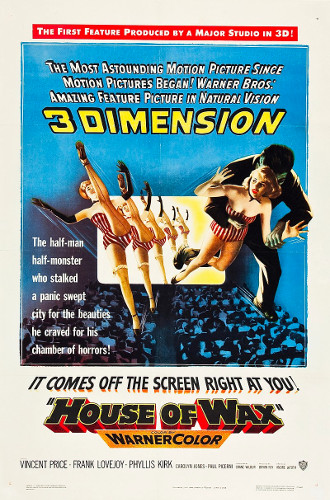
New York City 1900, sculptor Henry Jarrod operates a wax museum which specialises in historical figures. Business is failing so Henry’s business partner Matthew Burke starts a fire and leaves him to die so he can get insurance money from the place burning down. Some time later, Burke is murdered by a hideous monster who also takes his body from the morgue, the Burke’s fiancee Cathy is also killed, an act seen by Cathy’s roommate Sue Allen. Meanwhile it seems that Henry has survived and is about to open a new wax museum, though he must rely on assistants to create the sculptures as his hands and legs were badly burnt….
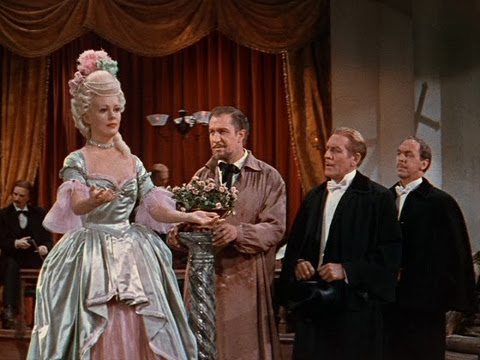
It’s easy to moan about remakes these days, and the trend does seem to have hit a peak, yet remakes have existed for nearly a century and have always been particularly popular in the horror genre. One film that isn’t a remake is 2005’s House Of Wax, which claims that it’s based on this 1953 production but actually has very little do to with it, turning the plot into simple slasher fare. But this House Of Wax is most definitely a remake, and of Mystery Of The Wax Museum, my review of which I posted earlier. The two make for an interesting comparison, the remake repeating the premise, most of the plot, and even some dialogue from the original, but tweaking things here and there and having a rather different aesthetic. In removing several characters, it dispenses with the whole reporter element, cuts other subplots to their bare minimum or removes them altogether, and concentrates more on the horror. A good example of its approach would be regarding its monster. In 1933, he was only in three scenes and his horrid visage was only seen at a distance; in 1953, he’s in a few more scenes and we get to appreciate his wonderful looks up close and personal. I know that a lot of lovers of vintage horror prefer the subtle approach, but I believe that both methods are of equal value and have equal effect, and it’s not as if this one also shows any bloody violence or gruesome details that aren’t made from wax – such things still weren’t seen much in 1953. While the newer film does have a great look to it, it doesn’t match the more stylised approach of the older. But the older one doesn’t have Vincent Price in the lead role which made him a horror star. He’d had a goodish start back in 1940 with The Invisible Man Returns, but his career didn’t take off as much as that of Claude Rains who’d played The Invisible Man seven years earlier.
The first feature length film to be shot in 3D was 1952’s Bwana Devil, an independent production which was a big hit. It was director Andre De Toth who thought up the idea of remaking The Mystery Of The Wax Museum in 3D. Warner Bros. contracted Julian and Milton Gunzburg’s Natural Vision 3-D system, the same one used for Bwana Devil, and filmed what was originally entitled The Wax Works despite De Toth being blind in one eye and unable to experience stereo vision or 3-D effects. Studio head Jack Warner told editor Rudi Fehr that he would have five weeks to edit the film after shooting was done. Fehr said they could get it done even quicker if De Toth would shoot in sequence, so Warner ordered De Toth to do that against De Toth’s protestations. De Toth liked realism on his sets, so he used a real guillotine blade for one near-death scene which actor Paul Picerni initially refused to do and then only agreed to do one take. House of Wax was the first commercially released movie to have a stereophonic three-track magnetic soundtrack, though many cinemas were not equipped to make use of it and defaulted to the standard monophonic optical soundtrack. The 3-D screenings also included an intermission, which was necessary to change the film’s reels, because each projector of the cinema’s two projectors was dedicated to one of the stereoscopic images. It came in under budget and was a major hit despite lousy reviews, and the 3D craze continued a little while longer. Price liked to attend screenings of this film in disguise. On one occasion he quietly took a seat behind two teenagers, and just after a particularly frightening scene, he leaned forward and asked them, “Did you like it?”, causing them to jump out of their seats.
For a while we proceed just as we did in 1933, though beginning our track through the first wax museum with the shadow of a person wielding a dagger is a nice touch. There are many of the same dummies and more dummies generally, but none of them seem to move this time despite some still obviously being played by people. The fight is the fire is much longer and better, and we feel Henry’s pain at seeing his “friends” dying before his very eyes more than we felt Ivan’s in 1933, though the melting mannequins don’t all look as startling. But Price seems looks alarmed, as well he might, because the three fires started on the set got out of control, put a hole in the roof and singed his eyebrows. But because the rapidly melting wax mannequins would have been very hard to replace, De Toth kept on filming even as firemen arrived to help extinguish the flames. In fact the actor also suffered elsewhere for his trouble, almost passing out several times when the rubber makeup was applied and stretched his skin, After this, things diverge from the original for quite a bit. We rejoin Henry’s ex-business partner Matthew who caused all this, telling his much younger fiancee Cathy Gray that he and Henry were “like that” and if only he’d been there to save him. Cathy’s played by Carolyn Jones who has one of those awful squeaky voices that makes you want to cover your ears, though I wonder if her interest in men with money is meant as a sly reference to the original’s Florence. Matthew returns home to be strangled in his room by the black cloaked, black hatted monster, who then makes it look like Matthew hung himself in the lift shaft. But Cathy is soon out with another potential sugar daddy while her roommate Sue gets in trouble for being behind with the rent. We really want to Sue to get it, and thankfully she does soon after.
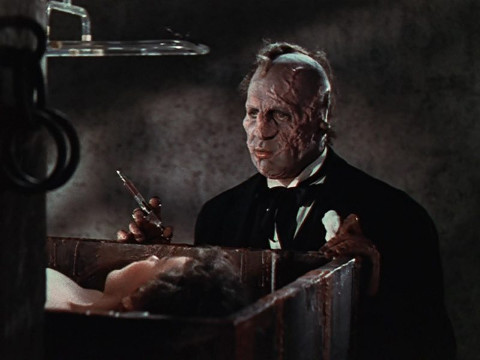
By now the original had cut to the investigation, but here we keep on with the action as Sue sees the killer and flees, resulting in a chase through empty, foggy streets in the only sequence that approaches the expressionism of the original, and which was copied loads of times, perhaps most notably by Mario Bava in Baron Blood who certainly topped it. We can tell that Sue’s being pursued through a large set, but the lush lighting [Bert Glennon and Peverell Marle are credited though I have no idea who shot what] helps to provide an almost fairy-tale ambience and one can only feel cheering when Sue actually stops long enough to remove her noisy and cumbersome high heeled shoes which give away her every step on the cobblestone roads. It’s only after all this that we get an almost exact reprise of the original’s mortuary scene, replete with, “Just like a woman, they have to have the last word” as a corpse sits out as a side effect from embalming fluid before the killer sits up on another bed. Now we meet the now wheelchair-bound Henry, explaining his intention of building a new wax museum with his assistants, conceding to popular taste more than his 1933 predecessor by including a chamber of horrors showcasing both historical crimes and recent events that include Matthew’s apparent suicide. Maybe this was intended as a comment on the audience’s possibly unhealthy liking for films such as House Of Wax, though this is as sophisticated as the film gets. Henry even explains and shows his waxing method this time around. Sue attends the opening of the museum and is troubled by the strong resemblance of the figure of Joan of Arc to Cathy. Henry claims that he used photographs of Cathy to make the sculpture, but Sue remains unconvinced while Henry hires her boyfriend Scott as an assistant. This is all familiar stuff sometimes given slight variations, but reduced in scale by things such as the roles of two female characters now being merged into one. The big unmasking is poorly staged with the mask coming off far too easily, and the climax far less lively if still basically the same.
The removal of the journalism angle is partly replaced by some police procedural stuff, and a bit more suspense and action including a fine bit where one of Henry’s assistants Igor [an early part for Charles Bronson who really dig look ugly when he was younger] stalks Sue in the museum at night, a scene which exploits the fear of wax mannequins and heads really well. Igor has a larger role than the similarly deaf-mute Hugo did in the earlier film, while Leon Averill’s is far smaller than that of Professor Darcy. He was a drug [probably heroin] addict in 1933 and treated like crap by most. But such a character would never be allowed in a film twenty years later so he becomes a drunk and not as pivotal to the story. The police seemed to take ages to get Darcy to talk and were pretty aggressive, but Leon is just sat down in front of a sergeant who keeps filling a small glass with some spirit, causing Leon to crack quite quickly. Mystery Of The Wax Museum is overall the more adult film despite House Of Wax’s greater emphasis on the grand guignol. But it’s wonderful to see Price doing his thing for the first time on screen, already forming his horror persona which quickly garnered him a huge fan base. Lines like, “If your look of horror should spoil your lovely face, what if it should show through the wax”? and [in reference to Henry XIII], “He invented the short cut to divorce” already seem perfect for Price’s unique combination of conviction and camp, and he already gets to be obsessed with beauty and a woman. The character being definitely a multiple murderer in this retelling is a good example of the simplication applied, but Price’s slouching, lame foot-dragging body movements almost give him the feeling of a wounded animal and are both chilling and pitiful. And that makeup is wonderfully horrid; so horrid in fact that Price wasn’t allowed in the staff canteen with it on as it was deemed too ghastly.
Except for Henry, Cathy and Matthew, characterisation is minimal and our nominal heroine and hero Phyliss Kirk and Paul Picerni are dull. But Stanley Fleischer’s sets are good in their own right, looking and feeling appropriately ‘period’ while providing just enough of the appropriate sense of unreality. David Buttolph’s music score is expectedly full-on and makes one wonder how Mystery Of The Wax Museum ever managed without one. As for 3D, we do get some moments that truly stick out, notably the shadowy figure of one of the characters seeming to spring up out of the theater audience and run into the screen which must have really caused a jolt, a focus on the legs of can-can girls far longer than would have normally be deemed decent, and not one but two scenes with a paddleball-wielding pitchman who repeatedly whacks the ball at the camera and at one point even breaks the fourth wall to say, “You! With the popcorn. Hold still”. Of course this sort of thing is distracting when watched flat and at home, but I don’t mind it because I’ve always considered 3D to be just a fun gimmick anyway; I know many others disagree but I don’t feel that it ever provides truly realistic depth. For this film, the process is ignored for much of the running time which peculiarly leaves the 1933 version with slightly more of a depth of field due to its particular use of dark and light. But which is better? I’ll just repeat what I said near the beginning of my review of Mystery Of The Wax Museum; that is probably a slightly better film and is certainly more artistic, but I personally think House Of Wax, which is overall a fine example of how to do a remake, is more fun to watch and it delivers more as a horror film. So I shall rate them both the same.
Rating: 











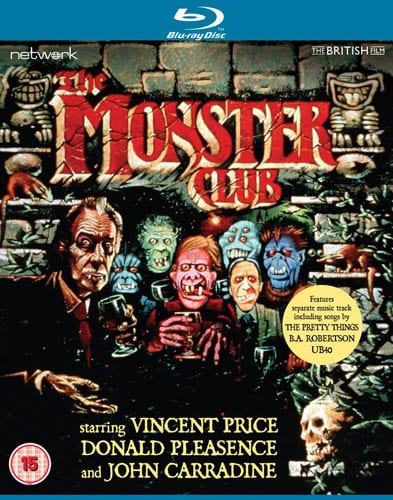

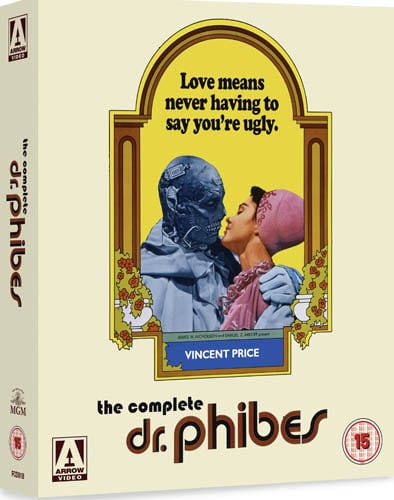
Be the first to comment